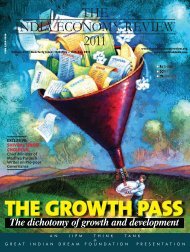Download - The India Economy Review
Download - The India Economy Review
Download - The India Economy Review
You also want an ePaper? Increase the reach of your titles
YUMPU automatically turns print PDFs into web optimized ePapers that Google loves.
management optimizes the use of<br />
the natural resource base to enhance ag-<br />
ricultural productivity goals, ensure long-<br />
term sustainability, and protect the liveli-<br />
hoods of poor and vulnerable families<br />
(ibid: 223).<br />
In <strong>India</strong>, the overall estimate is that 33<br />
percent of the tribals earn their livelihood<br />
from forests and forest products (Sarmah<br />
and Rai, 2001:207). <strong>The</strong> World Bank Re-<br />
port (2006) indicates that forests offer vast<br />
potential for poverty reduction and rural<br />
economy growth in <strong>India</strong> while also supporting<br />
critical national conservation<br />
goals (World Bank, 2006: xiii). <strong>The</strong> Report<br />
also reveals that half of <strong>India</strong>’s 89 million<br />
tribal people live in forest fringe areas and<br />
forests have the potential to improve the<br />
livelihoods of forest dwelling people, particularly<br />
tribal people who are the most<br />
disadvantaged group in <strong>India</strong>n society<br />
(ibid:2). Forest fringe households having<br />
more than 75 percent households under<br />
BPL category earn over 60 percent of<br />
their per capita net real annual income<br />
from forest source(Sarker and Das,<br />
2010:53). All forest fringe households<br />
under BPL category earn over 75 percent<br />
of their per capita net real annual income<br />
from forest source (Sarker 2009:78). Common<br />
property resources (CPRs) are especially<br />
important in <strong>India</strong> in supporting<br />
subsistent farming via the sustenance<br />
provided to farm animals (Rao, 2001:55).<br />
Based on the data from seven states in the<br />
dry tropical zone in <strong>India</strong>, Jodha (1986<br />
R ESOURCE PLANNING<br />
and 1991) concluded that poor households<br />
secure up to 23 percent of their<br />
income, 84 percent of their fuel supplies,<br />
and 84 percent of their annual grazing<br />
needs and 196 days of employment from<br />
CPRs.<br />
But neither the draft approach paper to<br />
the previous plan strategies nor the draft<br />
approach of Eleventh Five Year Plan of<br />
<strong>India</strong> (2007- 12) titled “Towards Faster<br />
and More Inclusive Growth’’ address this<br />
issue. As regards the draft approach of<br />
Eleventh Five Year Plan of <strong>India</strong> (2007-<br />
12) is concerned, the ‘source of growth’<br />
does not include natural capital, which is<br />
a major capital and a major source of<br />
livelihood of the masses in the <strong>India</strong>n<br />
economy. As the approach paper men-<br />
THE INDIA ECONOMY REVIEW<br />
137





